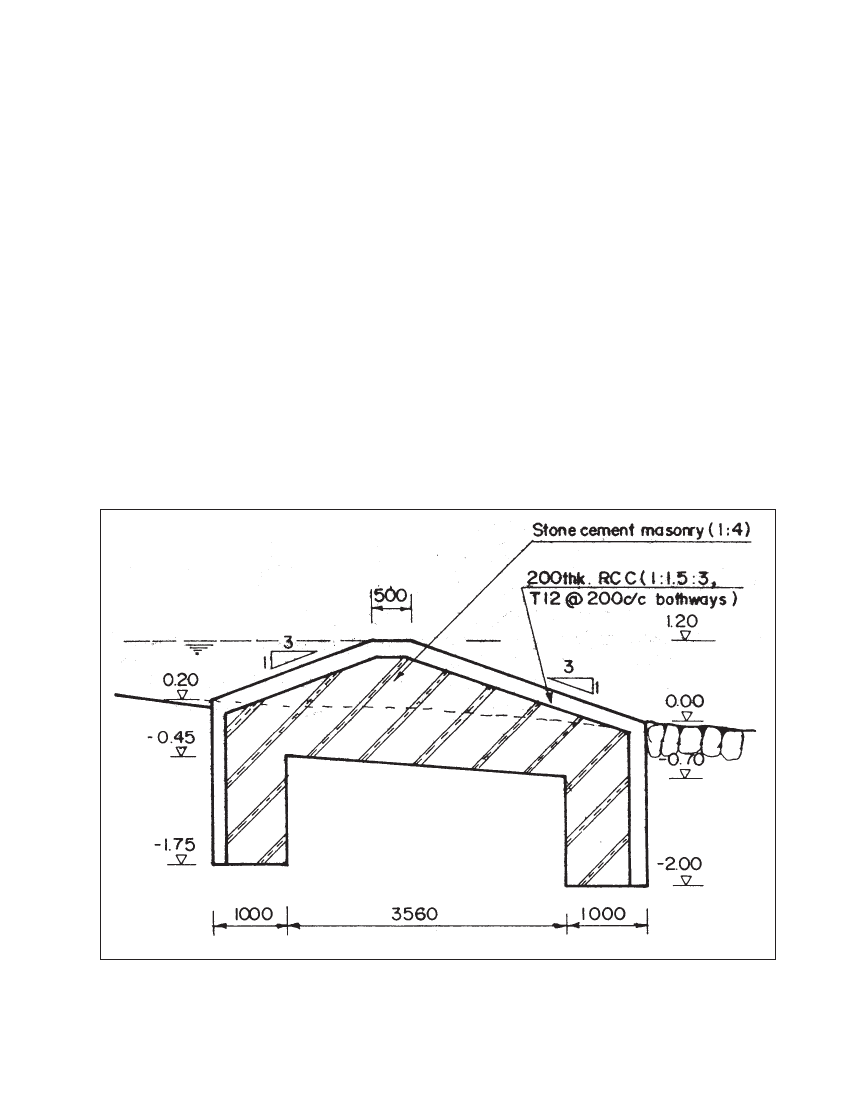
CIVIL WORKS GUIDELINES FOR MICRO-HYDROPOWER IN NEPAL
31
3.6.4 PERMANENT WEIR
Sometimes if there is a scarcity of water, especially during
the low flow season, and the river does not carry large boulders,
a permanent weir may be built across the river. Micro-hydro
schemes in the higher range (50 kW or above) and mini-
hydro schemes (100 kW to 1000 kW) often have permanent
weirs. Permanent weirs are generally constructed of mass
concrete (1:1.5:3 with 40% plums), or stone masonry in 1:4
cement mortar. A reinforced concrete surface layer may be
considered to protect the weir from damage by boulders moving
in flood. A more recent experience in Nepal in small
hydropower plans has been to line the weir surface using
300 mm hard stone in rich mortar (1 cement to 2 sand ratio)
instead of reinforced concrete, especially if large boulders
and sediment movement occur during floods. This
arrangement has more abrasion resistance capacity than that
of reinforced concrete and is relatively easy to repair, i.e.,
replace the abraded boulders with new ones using rich cement
mortar, whereas replacing reinforcement bars can require
welding works .
For micro-hydro scheme, generally a permanent weir should
only be considered if all of the following conditions are met:
Large boulders do not move in the river at the weir site.
The river bed is stable (not eroding, aggrading or shifting
course)
There is a scarcity of flow, especially in the dry season.
Skilled masons are locally available for both construction
and maintenance.
There are sufficient funds for both construction and future
maintenance work.
Even if all of the above conditions are met, further
consideration should be given for remote sites (3-4 days walk)
because of the cost and difficulty involved in transporting
cement and reinforcing steel. Besides considering the factors
mentioned earlier (use of large boulders, weir across part of
the river if possible and low weir height), for permanent weirs
scour protection should also be provided. The toe of the weir
(i.e., downstream face of the weir) is most susceptible to
scouring since there is a drop from the crest of the weir.
Protection against scour is provided by cut-off walls and placing
boulders (such as stone soling) or riprap downstream of the
weir as shown in Figure 3.10. The cut-off walls also reduce
seepage under the weir, which can increase the flow available
to the intake during the dry season. Figure 3.11 shows another
Note: All dimension are in mm, levels are in m.
Figure 3.10 A stone masonary parmanent weir proposed for Ghami micro-hydro scheme, Mustang, Nepal. The 1:3 slope allows rolling boulders to
travel downstream through the weir and the RCC blanket helps to strengthen the weir surface against abrasion due to rolling boulders. Also note
the cut-off wall and riprap at downstream face